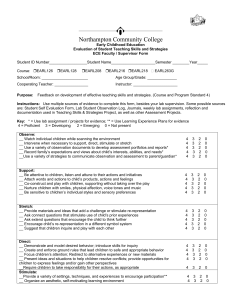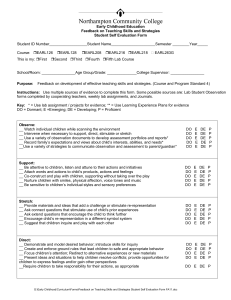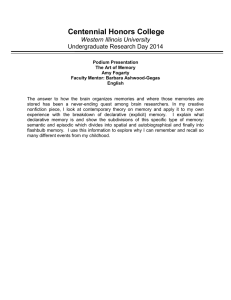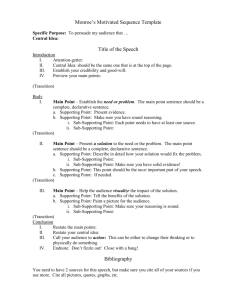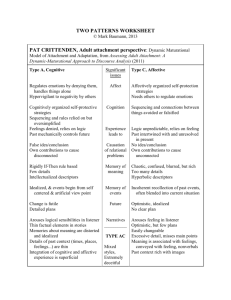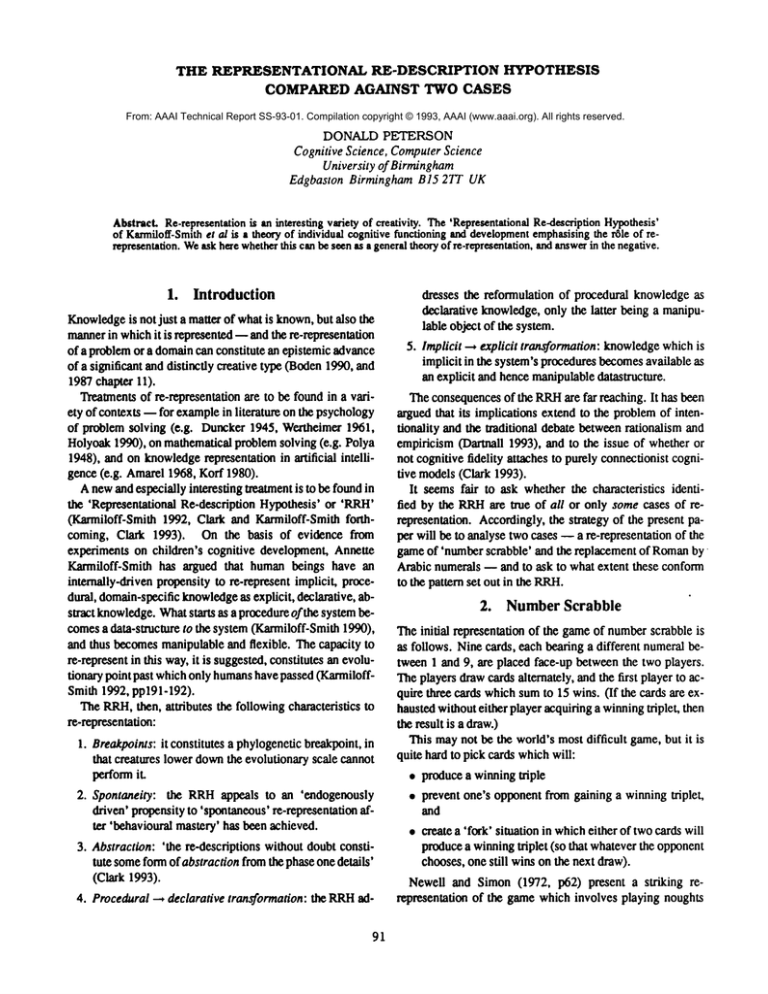
THE REPRESENTATIONAL
RE-DESCRIPTION
HYPOTHESIS
COMPARED AGAINST TWO CASES
From: AAAI Technical Report SS-93-01. Compilation copyright © 1993, AAAI (www.aaai.org). All rights reserved.
DONALD PETERSON
Cognitive Science, ComputerScience
University of Birmingham
Edgbaston Birmingham B15 2TT UK
Abstract. Re-representationis an interesting variety of creativity. The’RepresentationalRe-descriptionHypothesis’
of Karmiloff-Smith
et a/is a theory of individual cognitive functioningand development
emphasisingthe r61e of rerepresentation.Weask haewhetherthis can be seenas a generaltheory of re-representation,and answerin the negative.
1. Introduction
Knowledge
is not just a matter of what is known,but also the
mannerin whichit is represented -- and the re-representation
of a problemor a domaincan constitute an epistemic advance
of a significant and distinctly creative type (Boden1990, and
1987chapter 11).
Treamaentsof re-representation are to be found in a variety of contexts -- for examplein literature on the psychology
of problem solving (e.g. Duncker 1945, Wextheimer 1961,
Holyoak1990), on mathematical problem solving (e.g. Polya
1948), and on knowledgerepresentation in artificial intelligence (e.g. Amarel1968, Koff 1980).
A newand especially interestingtreatment is to be found in
the ’Representational Re-description Hypothesis’ or ’RRH’
(Karmiloff-Smith 1992, Clark and Karmiloff-Smith foilhcoming, Clark 1993). On the basis of evidence from
experiments on children’s cognitive development, Annette
Karmiloff-Smith has argued that human beings have an
internally-driven propensity to re-represent implicit, procedural, domain-specificknowledgeas explicit, declarative, abstract knowledge.Whatstarts as a procedureof the systembecomesa data-structure to the system (Karmiloff-Smith1990),
and thus becomesmanipulable and flexible. The capacity to
re-represent in this way,it is suggested,constitutes an evolutionary point past which only humanshave passed (KarmiloffSmith 1992, pp191-192).
The RRH,then, attributes the following characteristics to
re-representation:
1. Breakpoints: it constitutes a phylogeneticbreakpoint, in
that creatures lower downthe evolutionary scale cannot
perform
it.
dresses the reformulation of procedural knowledgeas
declarative knowledge,only the latter being a manipulable object of the system.
5. Implicit ---. explicit transformation: knowledgewhichis
implicit in the system’s proceduresbecomesavailable as
an explicit and hence manipulabledatastructure.
The consequencesof the RRHare far reaching. It has been
argued that its implications extend to the problemof intentionality and the traditional debate betweenrationalism and
empiricism (i)artnall 1993), and to the issue of whether
not cognitive fidelity attaches to purely connectionist cognitive models(Clark 1993).
It seems fair to ask whether the characteristics identified by the RRHare true of all or only some cases of rerepresentation. Accordingly, the strategy of the present paper will be to analyse two cases -- a re-representation of the
game of ’number scrabble’ and the replacement of Romanby
Arabic numerals -- and to ask to what extent these conform
to the pattern set out in the RRH.
2. NumberScrabble
The initial representation of the gameof numberscrabble is
as follows. Nine cards, each bearing a different numeralbetween 1 and 9, are placed face-up between the two players.
The players drawcards alternately, and the first player to acquire three cards whichsumto 15 wins. (If the cards are exhausted without either player acquiring a winningtriplet, then
the result is a draw.)
This maynot be the world’s most difficult game,but it is
quite hard to pick cards whichwill:
¯ produce a winningtriple
2. Spontaneity: the RRHappeals to an ’endogenously
driven’ propensity to ’spontaneous’re-representation aftea" ’behavioural mastery’ has been achieved.
3. Abstraction: ’the re-descriptions without doubt constitute someform of abstraction from the phase one details’
(Clark 1993).
4. Procedural---, declarative transformation: the RRHad91
¯ prevent
one’sopponent
fromgaining
a winningtriplet,
and
¯ create a ’fork’ situation in whicheither of two cards will
producea winningtriplet (so that whateverthe opponent
chooses, one still wins on the next draw).
Newell and Simon (1972, 1362) present a striking rerepresentation of the gamewhich involves playing noughts
and crosses over a 3 by 3 magicsquare (this being an arrangementof the numerals1 to 9, as below, so that each row, columnand diagonal sums to 15).
2
7
6
9
5
1
4
3
8
Fig. 1. magic square
The initial representation of the gamerequires us to proceed by using arithmetic calculation. In the magicsquare rerepresentation, the arithmetic features of the gameare ’built
into’ the diagram, and we can proceed by using our capacities
of spatial reasoning and pattern recognition. Thecrucial configurations such as winningtriples and forks are easily recognised in this way. Moreover,the procedures in question are
familiar to anyone whoalready knows howto play noughts
and crosses.
If numberscrabble were played over the telephone,and one
player secreOyused the magicsquare representation, it seems
clear that this would put that player at an advantage. And
the point for our general themeis that performanceis affected
here not just by what is knownabout the game, but also by
howit is represented.
3. Numerical Notation
A well knowncase of re-representation is the replacement of
Romannumerals with the nowfamiliar positional notation.
The modemsystem of decimal Arabic numerals uses a positional notation, the base 10, and the numeralzero. In this
system a numeral signifies a sum of products of powers of
the base, the powerbeing indicated by position: a numeral
ABCD signifies
(A× 103) + (B x I02) + (C x 10l) + (Dx 10°).
Throughhistory there have been a great manynumeralsystems. The Babylonians had a positional system with base 60
but without a zero. The Mayanshad a positional system with
zero and base 20, although here the 3rd digit indicates not
multiples of 202 but of 2018in order to give the days in their
year a simpler representation. The system of Romannumerals has manyvariants, but generally few primary symbolsare
used (e.g. I, V, X, L and C), and these are arrangedaccording
to additive and sublractive principles.
Different systems, of course, suite different purposes.
’Grouping systems’ are useful for keeping incremental tallies, and Romannumerals have the advantage that few primary symbols have to be remembered. But the overwhelming advantageof a positional systemwith zero is that a divideand-conquerstrategy for the basic arithmetic operations of addition, subtraction,multiplication and division becomespossible wherebya simple operation (involving ’carrying’), iterated along the numerals, achieves the purpose. It is not the
92
expressive poweroftbe notation whichis at issue here, but its
syntactic consistencyand the effect this has on the application
of arithmetic procedures.
Each digit has an associated multiplier (a power of the
base), and this multiplier is ’built into’ the syntaxin the form
of the digit’s position. Thusif two numeralsare ’lined up’,
so are their digits’ multipliers, and arithmetic operations can
proceed in a simple iterative manner.
With Romannumerals, however, lining two numerals up
together does not produce such a concordance. For example,
the numeral’XVII’is built on additive principles, while ’XIV’
is built on additive and subWactiveprinciples, and accordingly
the positions of the digits cannot be interpreted as with ’ 17’
and ’14’.
The advantage of positional over Romannumerical notation, then, is not a matter of expressive powerover a domain,
since both systems can denote numbers. Rather, it is due to
the possibility in positional notation of applying simple and
uniform arithmetic procedures.
4.
Comparison with the RRH
Twocases of advantageousre-representation have been given
brief consideration
above,and we nowturn to the question of
howwell these fit the picture given by the RRH.
4.1
BREAKPOINTS
RRHre-representation is put forward as constituting a phylogenetic breakpoint. Thereis no evident reason to deny this in
our two cases -- it seemsunlikely that monkeysor other nonhumancreatures could have invented these re-representations.
4.2
SPONTANEITY
RRHre-representation is ’endogenouslydriven’ or ’spontaneous’ in the sense that ’behavioural mastery’ has already
been achieved but re-representation takes place all the same.
The spirit of this account can be seen in our two cases -people do play numberscrabble using its standard representation, and Romanengineers did design bridges and aqueducts using Romannumerals. It seems clear therefore that
bebavionral mastery did precede our re-representations.
Howeverbebavionral mastery is a matter of degree, and
in our two cases it increases with re-representation. Number
scrabble and arithmetic becomeeasier, and we becomebetter
at themonce we are equipped with these re-representations.
Therefore wecan only say that their inventions followeda degree of behavionral mastery, not that they followed complete
mastery.
Spontaneity, further, is not a unitary issue. It maybe uue,
as the RRHsuggests, that humanshave a unique propensity
to re-represent in the absence of exogenouspressure. Andit
maybe true that non-positional systems were successful to
a degree. But it cannot be said that positional systems were
developedin the absence of ’pressure’ to improvearithmetic
facility.
previously implicit propositions about numbers.
In the case of number scrabble, declarative knowledge
RRHre-representations are more’abstract’ than their proceabout
triples whichsumto 15, and about the intersection patdural predecessors. However
it is not clear that this is flue in
tern
of
these triples has beenbuilt in to the diagram,and we
our two cases. The changeto Arabic numerals involves libermightsupposetherefore that it was used in creating and checkation from burdensome
syntax, but this is hardly "abstraction’.
ing the re-representation. However
this informationis not exAndin the case of numberscrabble, the re-representation is
plicit
in
the
final
diagram
without
someextra explanation
if anything less abstract and general, since it will only work
the
diagram
does
not
itself
tell
us,
declaratively and proposiif the rules remainunchangedand winningffiplets sum to 9.
tionally,
that
its
rows
columns
and
diagonals
all sumto 15.
The initial representation
in contrast could easily be changed
More
significantly,
the
point
of
the
re-representation
is not
in this respect.
to makethis knowledge
explicit, but rather to build it into the
syntax in such a wayas to facilitate the application of appro4.4 PROCEDURAL ~ DECLARATIVE
priate
procedures, in this case those of noughts and crosses.
TRANSFORMATION
The knowledgein question has not becomeexplicit, declarInRRHre-representation
theinitial
representation
isproceative and an "object of the system’ through re-representation
dural,
supporting
behavioural
mastery
butinflexible,
andthe
rather it wasexplicit in the first place, has beenusedin crere-representation
isdeclarative,
andtherefore
manipulable
by
ating
a re-representation, and is now’built in’ to a diagramin
the system.
the service of easy application of procedures.
In the case of numberscrabble, however,both the initial
Symptomatically,in using the re-representation of number
representation and the re-representation are procedural min
scrabble,
it is not evennecessary to knowhowto interpret it
both representations the user is not told a set of declarative
in
terms
of
explicit, declarative propositions about numbers
propositions, rather he or she is asked to engagein rule folsummingto 15. It wouldbe quite possible for one player to
lowing. The re-representation comprises the magic square diagramtogether with a set of heuristic rules for playing noughts play using the re-representation, while being unawarethat he
or she was playing numberscrabble ~ and win.
and crosses, and although declarative knowledgemight be
In contrast to RRHre-representation, then, it does not seem
neededto create and checkthis re-representation, the end rethat
the conversionof implicit into explicit knowledgeis essult is improvedprocedural knowledge.
sential
to either of our cases.
Accordingly,the virtues of the re-representation are not of
a declarative variety -- it does not allow moreexpressive or
5. Conclusion
more succinct statements about a domain. Rather they are of
a procedural type mthe load on working memoryand calcuThe cases of numberscrabble and arithmetic notation have
lation is reduced, since at any time the diagramhas a current
been presented in order to assess whether the ’Representational Re-description Hypothesis’ of Karmiloff-Smithet al
state, and it is relatively easy to determinehowto proceedto
can be treated as a 8eneral theory of re-representation (and
the next state.
not to assess it as a theory of cognitive development). Our
In the case of numerals it might be said that both repconclusion is in the negative, since the cases considered fit
resentations are broadly declarative, since both allow us to
the pattern of the RRHonly in somerespects, and in particuname numbers. Howeverthis is a weak sense of ’declaralar do not embodythe procedural ---, declarative and implicit
five’ since we can formulate only denoting expressions and
not propositions. And more importantly, the point of the
explicit transformations which the RRHpredicts.
re-representation concerns the operation
of arithmetic proceReferences
dures on numerals. Wedo not just want to write downnumbers, but also to performaddition, subtraction, multiplication,
AmarelS. 1968, "OnRepresentationsof Problemsof Reasoning
aboutActions’,in MichieD.(ed.). Machine
Intelligence3, Eddivision etc. on themas easily as possible. Andthis is greatly
inburgh.
facilitated by the positional systemwith zero.
BodenM. 1990, The Creative Mind:Mythsand Mechanisms,WeiIn neither of the present cases, then, is it accurate or sufdenfeld and Nicolson.
ficient to say that procedural knowledgeis re-represented as
Boden
M.1987, Artificial Intelligence andNaturalMan,2ndeeL,
Mrr.
declarative knowledge.
4.3 ABSTRACTION
4.5
IMPLICIT
---*
EXPLICIT
TRANSFORMATION
In RRHre-representation, whatis madeexplicit in the declarative re-representationis implicit in the initial proceduralrepresentation.
It is hard to see that somethingof this sort obtains with our
two numeral systems. A simpler syntax has been introduced,
allowingeasier application of arithmetic procedures, but it is
not evident that this essentially constitutes the emergenceof
93
Clark A. 1993, "Connectionism,
Non-conceptual
Contentand RepresentationalRe-description",
in Darmall
T. (ed.), Artificial Intelligence andCreativity, Kluwer.
Clark A. and Karmiloff-Smith
A. (forthcoming),"The Cognizer’s
Innards: a psychologicalandphilosophicalperspectiveon the
developmentof thought". MindandLanguage.
DarmallT. 1993, "Creativity, Thoughtand Re-description", in
DartaallT. (ed.), Artifu:ial IntelligenceandCreativity,Kluwer.
DunckerK. 1945, "on ProblemSolving", in PsychologicalMonographs,vol. 58, no 270.
Holyoak
K. 1990,"Problem
Solving’,
inOsherson
D.N.andSmith
E.E.(ed.s),
Thinking:
anInv;tatlon
toCo#nitive
Science,
vol.
3, MIT.
Ksrmiloff-Smith
A. 1990,"Constraints
on Re~esentationaI
Change:Evidence from Children’s Drawing, Cognition,
vol. 34, pp57-83.
Karmiloff-Smith A. 1992, Beyond Modularity: A Developmental
Perspective on Cognitive Science, MIT/Br~lford.
Koff E.R. 1980, "row&dsa Model of Rel~resentsfional Ch~ges’,
in Artificial Intelligence, 14, pp 41-78.
Newell A. and Simon A. 1972, HumanProblem Solving, Prentice
Hall.
Pete~son D.M.1993, "three Cases of Re-representation in Problem Solving", in Dar~all T. (od.), Artifu:ial Intelligence and
Creativity, Kluwer.
Polya 1948, Howto Solve It, Princeton.
Wertheimer1961, Productive Thinking, Tavistock Publications.

